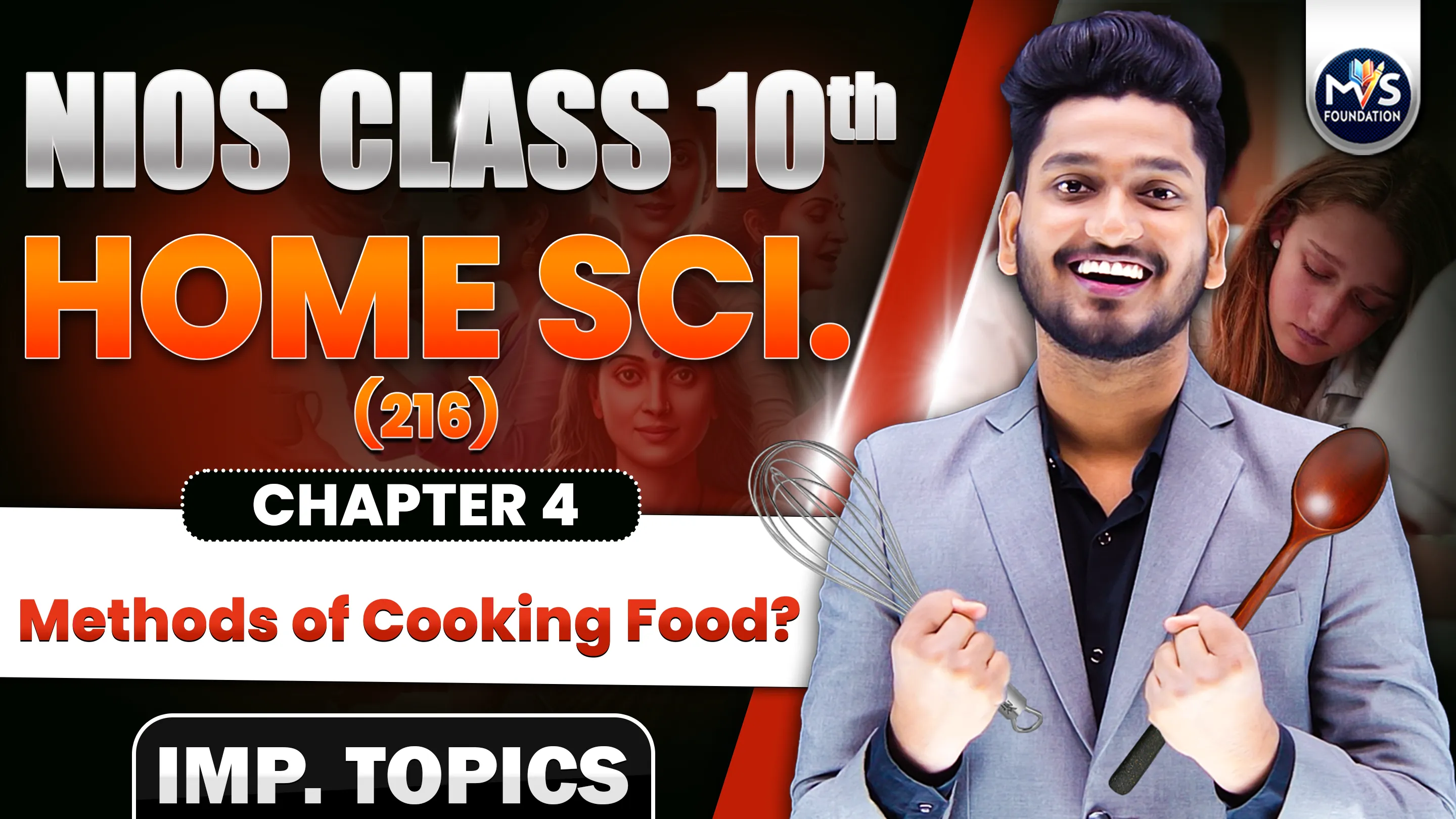
Get in Touch
We will get back to you within 24 hours.
Welcome to MVS Blog

NIOS Class-10th Chapter wise Important Topics
HOME SCIENCE(216)
Ch. 4 Methods of Cooking Food?
Ques 9. Describe the methods of cooking food.
Answer -
(A) Cooking by moist heat
In this method, food is put into boiling water or cooked in the steam which comes out from the boiling water.
(i) Boiling - Boiling is a method by which food is cooked in adequate quantity of water. For example, boil potatoes, eggs, rice and vegetables. Usually green leafy vegetables such as cabbage, fenugreek and spinach are cooked without adding extra water.
(ii) Simmering or Stewing - Stewing is cooking food in a small quantity of water kept below boiling point and for a long time. Once boiling starts, the flame is lowered and the food is allowed to cook slowly. The food and the liquid in which it is cooked are served together. This method is used when cooking dry and hard food items and vegetables. For example, pulses, meat and vegetables.
(iii) Steaming - When food is cooked with the heat from water vapours, it is called steaming.
The lower pan contains water, the pan above this has tiny holes on its base and the food is kept in it. A tight fitting lid covers this food. When water boils in the lower pan the steam comes into the upper pan through holes and cooks the food kept here.
(iv) Pressure Cooking -
Pressure cooking is a process of cooking in a special utensil which allows cooking with a lot of steam under pressure. Pressure cookers are made of steel or from a mixture of aluminium and other metals and can withstand high pressure. Rice, pulses, meat, potatoes, roots, beans, and peas are cooked well in a pressure cooker in the shortest possible time.
(B) Cooking by dry heat
The temperature used is as high as 200-300°C. Dry heat cooking gives a crisp texture, brown colour and pleasant flavor to the foods.
(i) Baking - Baking is the method by which food is cooked by placing it inside a heated closed box called an oven. The air inside the oven gets hot due to fire lit at its base or with electricity and the food gets cooked by hot air, when placed inside. For example Tandoori Roti, naan, pav, buns, biscuits, breads and pastries.
(ii) Roasting - Another method of cooking food by dry heat is roasting. While roasting, the food is put directly on a hot tava or girdle or sand or fire and cooked. For example brinjals, potatoes and sweet potatoes, ground nuts, cashew nuts and papad.
(iii) Grilling - Grilling is cooking over a glowing fire and uses more indirect heat and is slower than roasting. The food is supported on an iron grid over the fire, or between electrically heated grill bars. The grill bars are brushed with oil to prevent food sticking and can be heated by charcoal, gas or electricity. For example, Potato, sweet potato, brinjal, chicken and fish.
(C) Frying
Frying is the process of cooking food in hot ghee or oil. Food can be cooked either by shallow frying or by deep frying. Shallow frying means frying in little oil and deep frying means immersing food fully in hot ghee or oil.
Other cooking methods
✅ Click here to access all accurate and important topics!
Click here for Home Science (216)
Ques 10. What is conservation of nutrients? Suggest ways to conserve nutrients.
Answer - Conservation of nutrients: Conservation of nutrients means saving nutrients during the process of preparation and cooking of food.
Following are the methods of preserving nutrients:
Ques 11. Describe the methods of enhancing nutritional elements in food.
Answer - Enrichment of nutritional elements in food is done by the following methods:
1. Combination
No single food provides us all the nutrients. Hence, we eat a variety of food. Combining foods from different food groups is the easiest way of eating all nutrients. Similarly we can also combine a number of food items in one dish and get all the nutrients from it.
For example, when we mix rice and pulses, the quality of proteins in it becomes as good as that of milk. Similarly, vegetables like spinach, fenugreek and carrots contain abundant amounts of vitamins and minerals. When these are included in the diet, there is a massive increase in the nutritional elements of the food.
Benefits: Diet quality can be improved by combining two foods from the same food group or different food groups without increasing food costs. This is a common technique which can be easily used in every family.
2. Fermentation
Fermentation is a process in which microorganisms present in food or included in the form of curd etc. convert the nutrients already present in the food into a simpler and better form. In this process, some new nutrients like Vitamin C and Vitamin B complex are also produced.
For example, curd, bread, khaman, dhokla and idli are examples of fermented food.
Benefit:
3. Germination
Take whole moong or gram grains and soak them overnight in some water. The next day their shape will change and they will become soft to touch. If both of them are tied in a muslin cloth and left for 12 or 14 hours, then small sprouts are emerging from them. This process is called “germination”.
The time and amount of water used to germinate each grain or pulse is different. Normal soaking takes 8 to 16 hours and germination takes 12 to 24 hours. The cloth in which soaked pulses are tied should be kept moist all the time.
Benefit:
✅ Click here to access all accurate and important topics!
Click here for Home Science (216)
0 Response